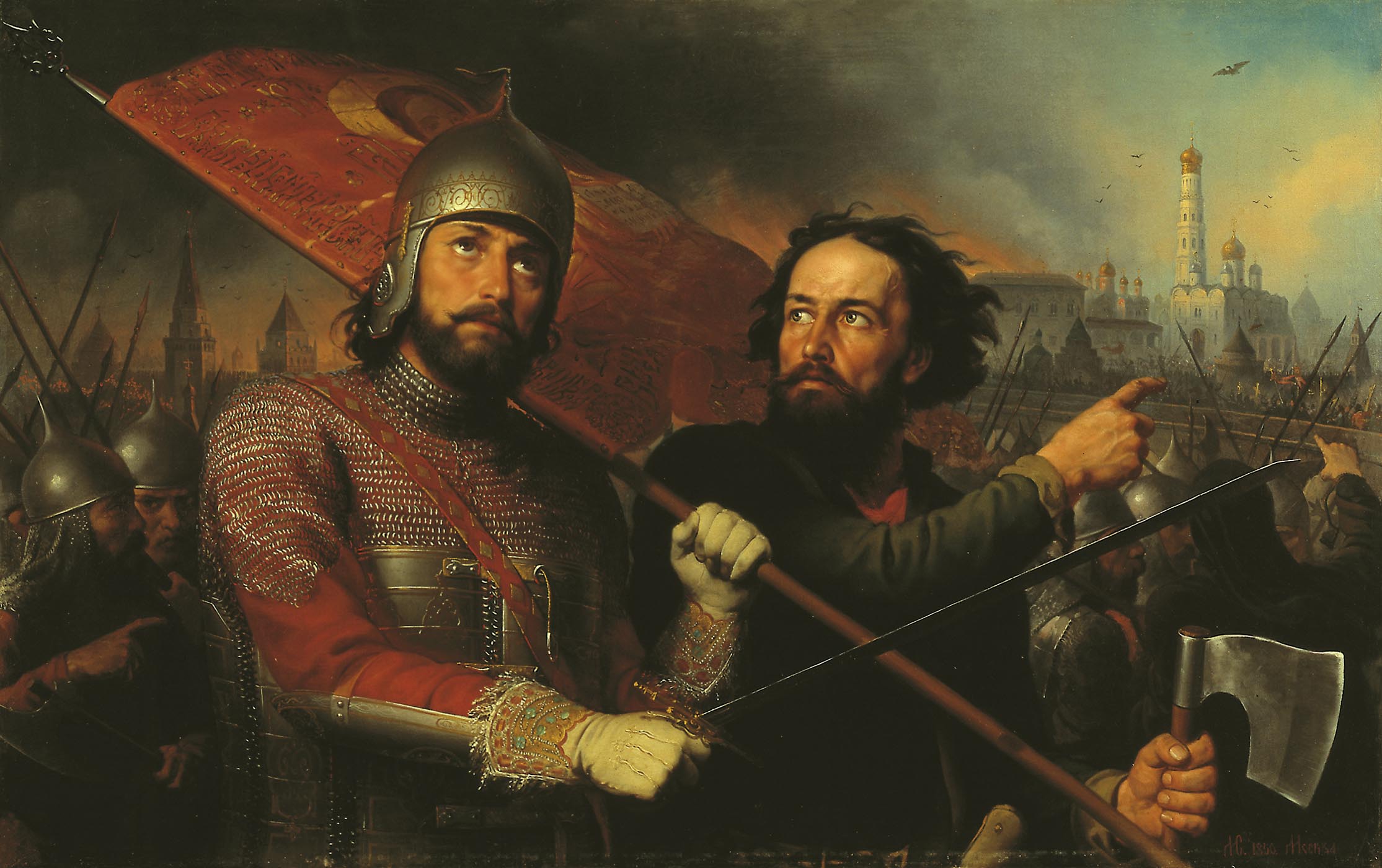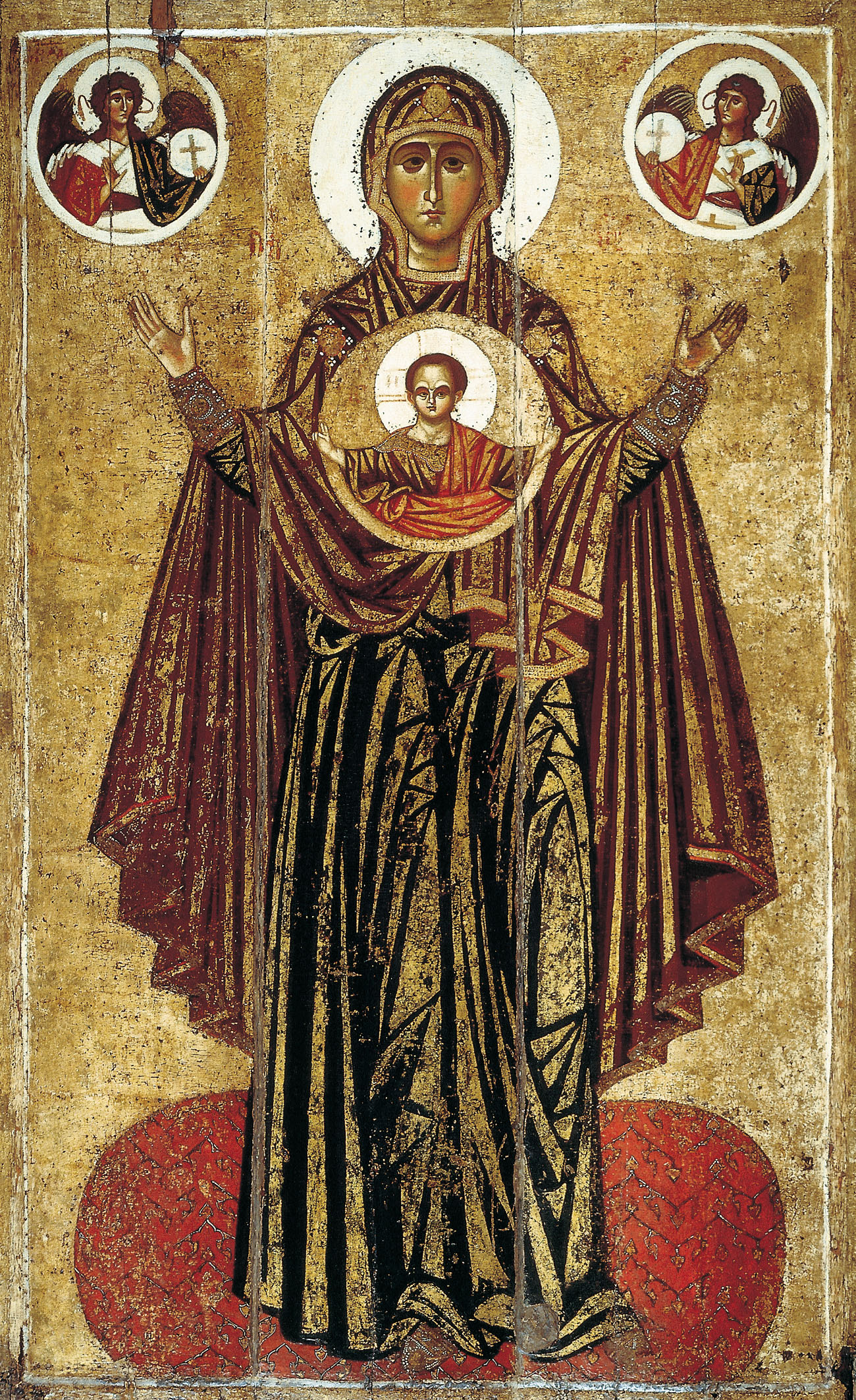|
Patriarch Hermogenes Of Moscow
Hermogenes, or Germogen (russian: Гермоге́н) (secular name Yermolay) (before 1530 – 17 February 1612) was the Patriarch of Moscow and all Russia from 1606. It was he who inspired the popular uprising that put an end to the Time of Troubles. Hermogenes was glorified by the Russian Orthodox Church in 1913. At the Holy Synod of 1589, which established the patriarchy in Moscow, Hermogenes was appointed Metropolitan of the newly conquered city of Kazan. During the following two decades, he gained renown for a number of Muslim Volga Tatars converted to Eastern Orthodoxy. In 1606, Hermogenes was summoned by False Dmitry I to take part in the Senate recently instituted in Moscow. There he learnt about the tsar's design to marry a Roman Catholic woman, Marina Mniszech, and firmly declared against such an alliance. At that he was exiled from the capital, only to return with great honours several months later, when the false tsar had been deposed, and Patriarch Ignatius followe ... [...More Info...] [...Related Items...] OR: [Wikipedia] [Google] [Baidu] |
Patriarch Of Moscow And All The Rus'
The Patriarch of Moscow and all Rus' (russian: Патриарх Московский и всея Руси, translit=Patriarkh Moskovskij i vseja Rusi), also known as the Patriarch of Moscow and all Russia, is the official title of the Bishop of Moscow who is the primate of the Russian Orthodox Church. It is often preceded by the honorific "His Holiness". While as the diocesan bishop of the Moscow diocese he has direct canonical authority over Moscow only, the Patriarch has a number of church-wide administrative powers within and in accordance with the charter of the Russian Orthodox Church. [...More Info...] [...Related Items...] OR: [Wikipedia] [Google] [Baidu] |
Roman Catholic
Roman or Romans most often refers to: *Rome, the capital city of Italy *Ancient Rome, Roman civilization from 8th century BC to 5th century AD *Roman people, the people of ancient Rome *'' Epistle to the Romans'', shortened to ''Romans'', a letter in the New Testament of the Christian Bible Roman or Romans may also refer to: Arts and entertainment Music * Romans (band), a Japanese pop group * ''Roman'' (album), by Sound Horizon, 2006 * ''Roman'' (EP), by Teen Top, 2011 *" Roman (My Dear Boy)", a 2004 single by Morning Musume Film and television * Film Roman, an American animation studio * ''Roman'' (film), a 2006 American suspense-horror film * ''Romans'' (2013 film), an Indian Malayalam comedy film * ''Romans'' (2017 film), a British drama film * ''The Romans'' (''Doctor Who''), a serial in British TV series People *Roman (given name), a given name, including a list of people and fictional characters *Roman (surname), including a list of people named Roman or Romans *Ῥωμ� ... [...More Info...] [...Related Items...] OR: [Wikipedia] [Google] [Baidu] |
Prince Pozharsky
Dmitry Mikhaylovich Pozharsky ( rus, Дми́трий Миха́йлович Пожа́рский, p=ˈdmʲitrʲɪj mʲɪˈxajləvʲɪtɕ pɐˈʐarskʲɪj; 17 October 1577 – 30 April 1642) was a Tsardom of Russia, Russian prince known for his military leadership during the Polish–Muscovite War (1605–1618), Polish–Muscovite War from 1611 to 1612. Pozharsky formed the Second Volunteer Army with Kuzma Minin in Nizhny Novgorod against the Polish–Lithuanian Commonwealth's occupation of Russia during the Time of Troubles, resulting in Polish withdrawal after Russian victory at the Battle of Moscow (1612), Battle of Moscow in 1612. Pozharsky received the unprecedented title of ''Saviour of the Fatherland'' from Mikhail I of Russia, becoming a folk hero in Russian culture and honored in the Monument to Minin and Pozharsky in Moscow's Red Square. Early career Dmitry Mikhaylovich Pozharsky is considered to have been born on 1 November 1578 in Klin County, in the north of Moscow ... [...More Info...] [...Related Items...] OR: [Wikipedia] [Google] [Baidu] |
Kuzma Minin
Kuzma (Kozma) Minin (; full name Kuzma Minich Zakhariev-Sukhoruky, born late 1570s - died 1616) was a Russian merchant from Nizhny Novgorod, Russia, who, together with Prince Dmitry Pozharsky, became a national hero for his role in defending the country against the Polish invasion in the early 17th century.'' ..igismund, changing his mind, demanded direct personal control of Russia and continued the Polish invasion (autumn 1610). This finally stimulated the Russians to rally and unite against the invader."''from:Troubles, Time of" Encyclopædia Britannica. 2006. Encyclopædia Britannica Premium Service. 12 June 2006 (accentuation added)''During the "Time of Troubles" (1598–1613), ozharskyfought against the Poles, who, taking advantage of unstable political conditions, had invaded Russia. In 1611 he took command of a national militia formed on the initiative of the merchant Kuzma Minin of Nizhny Novgorod. With his improvised army he marched on Moscow (1612) and drove out the Po ... [...More Info...] [...Related Items...] OR: [Wikipedia] [Google] [Baidu] |
Chudov Monastery
The Chudov Monastery (russian: Чу́дов монасты́рь; more formally known as Alexius’ Archangel Michael Monastery) was founded in the Moscow Kremlin in 1358 by Metropolitan Alexius of Moscow. The monastery was dedicated to the miracle (''chudo'' in Russian) of the Archangel Michael at Chonae (feast day: ). The Monastery was closed in 1918, and dismantled in 1929. The construction of the monastery together with its ''katholikon'' (cathedral) was finished in 1365. The katholikon was replaced with a new one in 1431 and then once again in 1501–1503. It was traditionally used for baptising the royal children, including future Tsars Feodor I, Aleksey I and Peter the Great. The monastery’s hegumen (abbot) was considered the first among the hegumens of all the Russian monasteries until 1561. Alongside Simonov Monastery and Trinity-St. Sergius Lavra, the Chudov Monastery was the biggest center of the Muscovite book culture and learning. Prominent monks of the monaster ... [...More Info...] [...Related Items...] OR: [Wikipedia] [Google] [Baidu] |
Roman Catholics
The Catholic Church, also known as the Roman Catholic Church, is the largest Christian church, with 1.3 billion baptized Catholics worldwide . It is among the world's oldest and largest international institutions, and has played a prominent role in the history and development of Western civilization.O'Collins, p. v (preface). The church consists of 24 ''sui iuris'' churches, including the Latin Church and 23 Eastern Catholic Churches, which comprise almost 3,500 dioceses and eparchies located around the world. The pope, who is the bishop of Rome, is the chief pastor of the church. The bishopric of Rome, known as the Holy See, is the central governing authority of the church. The administrative body of the Holy See, the Roman Curia, has its principal offices in Vatican City, a small enclave of the Italian city of Rome, of which the pope is head of state. The core beliefs of Catholicism are found in the Nicene Creed. The Catholic Church teaches that it is the on ... [...More Info...] [...Related Items...] OR: [Wikipedia] [Google] [Baidu] |
Prokopy Lyapunov
Prokopy Petrovich Lyapunov () (Isady, Grand Duchy of Moscow; Grand Duchy of Ryazan became a part of Grand Duchy of Moscow in 1521 and Moscow shouldn't be confused as a birth place which is located to the east of Old Ryazan, in a village that survived to this day b. ? — July 22, 1611;Most sources agree that he died no later than August 1, 1611 Tsardom of Russia) was a prominent 17th century Russian nobleman (dvoryanin), voivode (military chieftain) of, allegedly, a Rurikid origin who practically became a head of Pereyaslavl-Ryazansky lands nobility in the end 1590s; he took part in wars during power vacuum in succession crisis that happened in early 1598 as result of confusion about legitimate heir apparent following death of Feodor I, nobility infighting, war declared by Polish–Lithuanian Commonwealth (PLC) in 1605, and exhaustive Tatar raids; most famously he is remembered for organizing and leading the first unsuccessful uprising against occupation of Moscow of 1610 by ... [...More Info...] [...Related Items...] OR: [Wikipedia] [Google] [Baidu] |
Moscow Kremlin
The Kremlin ( rus, Московский Кремль, r=Moskovskiy Kreml', p=ˈmɐˈskofskʲɪj krʲemlʲ, t=Moscow Kremlin) is a fortified complex in the center of Moscow founded by the Rurik dynasty. It is the best known of the kremlins (Russian citadels), and includes five palaces, four cathedrals, and the enclosing Kremlin Wall with Kremlin towers. In addition, within this complex is the Grand Kremlin Palace that was formerly the Tsar's Moscow residence. The complex now serves as the official residence of the President of the Russian Federation and as a museum with almost 3 million visitors in 2017. The Kremlin overlooks the Moskva River to the south, Saint Basil's Cathedral and Red Square to the east, and the Alexander Garden to the west. The name "''Kremlin''" means "fortress inside a city", and is often also used metonymically to refer to the government of the Russian Federation. It previously referred to the government of the Soviet Union (1922–1991) and its high ... [...More Info...] [...Related Items...] OR: [Wikipedia] [Google] [Baidu] |
Ivan Bolotnikov
Ivan Isayevich Bolotnikov (russian: Ива́н Иса́евич Боло́тников; 1565–1608) headed a popular uprising in Russia in 1606–1607 known as the Bolotnikov Rebellion (Восстание Ивана Болотникова). The uprising formed part of the Time of Troubles in Russia. Early life Describing Bolotnikov, Paul Avrich states, "Contemporaries depict him as tall and powerfully built and as an intelligent and energetic leader." Bolotnikov was a slave of Prince Andrei Teliatevsky, before running away to join the Cossacks along the steppe frontier between Muscovy and the Crimean Khanate. Captured by the Crimean Tatars, he was sold into slavery as a helmsman for a Turkish galley. Liberated in a sea battle by German ships, he was taken to Venice. Journeying back to Muscovy, he passed through Poland, where he heard tales of the Tsar Dmitri. This led Bolotnikov to Sambor, where he met Mikhail Molchanov. Molochanov was part of the group who had murdered Feodor ... [...More Info...] [...Related Items...] OR: [Wikipedia] [Google] [Baidu] |
Donkey
The domestic donkey is a hoofed mammal in the family Equidae, the same family as the horse. It derives from the African wild ass, ''Equus africanus'', and may be classified either as a subspecies thereof, ''Equus africanus asinus'', or as a separate species, ''Equus asinus''. It was domesticated in Africa some years ago, and has been used mainly as a working animal since that time. There are more than 40 million donkeys in the world, mostly in underdeveloped countries, where they are used principally as draught or pack animals. While working donkeys are often associated with those living at or below subsistence, small numbers of donkeys or asses are kept for breeding or as pets in developed countries. A male donkey is known as a ''jack'' or ''jackass'', a female is a ''jenny'' or ''jennet'', and an immature donkey of either sex is a '' foal''. Jacks are often mated with female horses (mares) to produce '' mules''; the less common hybrid of a male horse (stallion) and j ... [...More Info...] [...Related Items...] OR: [Wikipedia] [Google] [Baidu] |
Panagia
Panagia ( el, Παναγία, fem. of , + , the ''All-Holy'', or the ''Most Holy''; pronounced ) (also transliterated Panaghia or Panajia), in Medieval and Modern Greek, is one of the titles of Mary, mother of Jesus, used especially in Eastern Catholicism and Orthodox Christianity. Most Greek churches dedicated to the Virgin Mary are called ''Panagia''; the standard western Christian designation of "St. Mary" is rarely used in the Orthodox East, as Mary is considered the holiest of all created beings and therefore of higher status than the Saints. Iconography ''Panagia'' is also the term for a particular type of icon of the Theotokos, wherein she is facing the viewer directly, usually depicted full length with her hands in the ''orans'' position, and with a medallion showing the image of Christ as a child in front of her chest. This medallion symbolically represents Jesus within the womb of the Virgin Mary at the moment of the Incarnation. This type of icon is also called t ... [...More Info...] [...Related Items...] OR: [Wikipedia] [Google] [Baidu] |


.jpg)



